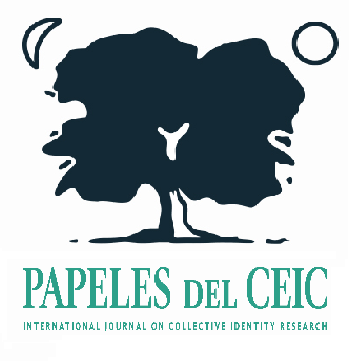The Extraction of the Stone of Memory. Subaltern aesthetics under Francisco Franco's dictatorship: the works of mason José Meijón
##plugins.themes.bootstrap3.article.main##
##plugins.themes.bootstrap3.article.sidebar##
Abstract
This article offers a case study after the works by mason José Meijón, an artist subjected to psychiatric discipline that, during fifty years, developed a fascinating project over the stones around the town of Marin (Pontevedra, Galicia). His invisible art represents today a telling testimony of the repression under Francisco Franco's dictatorship and of the problems related to the Spanish Civil War's memories. I will defend a possible reconstruction of Meijon's artistic corpus and a number of reading strategies to offer a comprehension of his work in relation to authoritarian developmentalist politics between 1931 and 1980. In order to do so, I will display Meijon's biography and oral legend in relation to his works and to the social and cultural space from which they originate. My goal is to offer a comprehensive reading taking into account history, biography, aesthetics and the space as a whole. In section two, I will present a short political history of Marin's territory and its transformations since the Spanish Civil War, to provide a general frame for Meijon's art. Section three, interrogates his art in relation to the local prehistoric engravers that he explicitly quotes, updating their codes in terms of avant-garde aesthetics. By means of this gesture, Meijon is organizing a memorial writing for the rich religious (protestant) and political (working-class and Republican) local democratic universe, destroyed during the war. Finally, I am interested in focusing political tensions that Meijon’s works arise today face to our so-called processes for the recovering of historical memory.
How to Cite
##plugins.themes.bootstrap3.article.details##
subalternity, historical memory, Francoism, art brut
Castelao, A. (1949). As Cruces de Pedra na Galiza. Buenos Aires: Nós.
Cortés, N. (2016). O incomprendido Pepe Meijón. Diario de Pontevedra, Ago. 28.
Delgado, E. (2014). La nación singular. Fantasías de la normalidad democrática española (1996-2011). Madrid: Siglo XXI.
Deleuze, G., y F. Guattari (1973). El anti-Edipo. Capitalismo y esquizofrenia. Barcelona: Barral.
Fernández Prieto, L. (1992). Labregos con ciencia. Vigo: Ed. Xerais.
Ferrándiz, F. (2014). El pasado bajo tierra. Exhumaciones contemporáneas de la Guerra Civil. Madrid: Anthropos.
Ferrándiz, F., Robben, A., y Wilson, R. (2015). Necropolitics: mass graves and exhumations in the age of human rights. Philadelphia: University of Pennsylvania Press.
Gago, M. (2007). Enrique Turrall. En los campos de Galicia. Marín: Publicidad y Artes Gráficas Dibay.
Gago, M. (2017). Persecución contra os protestantes na Guerra Civil e no franquismo. Asociación pola Recuperación da Memoria Histórica de Marín (Pontevedra), 15 Oct.
Hernández, J.F. (2013). Singular Spaces: From the Eccentric to the Extraordinary in Spanish Art Environments. San Jose: San Jose State University.
Labrador Méndez, G. (2010). Teleliberalismo o república inalámbrica? Hispanic Review, 78(4), 579-582.
Mbembé, A. (2001). On the postcolony. Berkeley: University of California Press.
Mbembé, A. (2003). Necropolitics. Public Culture, 15(1), 11-40.
Milleiro, C. (2014). Rúa do polígono de tiro naval Janer. Pontevedraviva.com, Feb. 19. Disponible en: https://pontevedraviva.com/opinion/926/celso-milleiro-poligono-tiro-naval-janer/.
Milleiro, C., y Moreira, X.M. (2017). Memorias de sal e terra: o ensino no Concello de Marín (1867-1940). Pontevedra: Diputación de Pontevedra.
Pérez Ocaña, Ó.L. (2011). Land Art en España. Rubí: Ediciones Rubeo.
Piedras Monroy, P. (2012). La siega del olvido. Memoria y presencia de la represión franquista. Madrid: Siglo XXI.
Pontevedra, S.R. (2012). El hombre que nació 4.000 años tarde. El País, Mayo 21.
Ramírez, J.A. (2013). Escultecturas margivagantes. La arquitectura fantástica en España. Madrid: Siruela.
Santiago, L. (2017). Paraíso roubado. Pontevedra: Asociación pola Defensa da Ría.
Torrado, R. (1948). Botón de Ancla. España: Suevia Films.
Papeles del CEIC is distributed under the licence Creative Commons Reconocimiento-NoComercial-SinObraDerivada 3.0 España (CC BY-NC-ND 3.0 ES)
Usted es libre de:
- copiar, distribuir y comunicar públicamente la obra
Bajo las condiciones siguientes:
- Reconocimiento — Debe reconocer los créditos de la obra de la manera especificada por el autor o el licenciador (pero no de una manera que sugiera que tiene su apoyo o apoyan el uso que hace de su obra).
- No comercial — No puede utilizar esta obra para fines comerciales.
- Sin obras derivadas — No se puede alterar, transformar o generar una obra derivada a partir de esta obra.
Entendiendo que:
- Renuncia — Alguna de estas condiciones puede no aplicarse si se obtiene el permiso del titular de los derechos de autor
- Dominio Público — Cuando la obra o alguno de sus elementos se halle en el dominio público según la ley vigente aplicable, esta situación no quedará afectada por la licencia.
- Otros derechos — Los derechos siguientes no quedan afectados por la licencia de ninguna manera:
- Los derechos derivados de usos legítimos u otras limitaciones reconocidas por ley no se ven afectados por lo anterior.
- Los derechos morales del autor;
- Derechos que pueden ostentar otras personas sobre la propia obra o su uso, como por ejemplo derechos de imagen o de privacidad.
- Aviso — Al reutilizar o distribuir la obra, tiene que dejar bien claro los términos de la licencia de esta obra.
The author can use his/her article freely always indicating that it has been published in Papeles del CEIC. International Journal on Collective Identity Research. Any re-edition of the article must be approved by the journal editorial team.


 http://orcid.org/0000-0003-4183-4776
http://orcid.org/0000-0003-4183-4776